The new Marine infantry battalion is slimmer, saltier and more techy
A slimmer, more senior and technology-driven Marine infantry battalion structure now unfolding across the service will shape the deployments, careers and lives of future riflemen, the most essential element of the service’s combat power.
The new infantry battalion reduces the former standard manning of the battalion from 965 Marines down to 811 Marines while also adding a host of new technologies to vastly increase the strike, sensing, communication and firepower of the unit.
But that was only phase one of a two-phase experimentation plan.
The next phase will refine how the battalion ― the Corps’ lowest echelon unit capable of independent, extended combat employment and the foundation of a variety of formations that have earned the service it’s “force-in-readiness” calling card ― moves, shoots, communicates and cares for its wounded. Planners expect the next fight will be a vast battlefield dotted with dispersed units facing firepower not seen since heavy combat of the mid-20th century.
Phase two kicks off later in 2023 with 3rd Battalion, 4th Marine Regiment, out of Marine Corps Air Ground Combat Center, Twentynine Palms, California. Leading that effort are battalion commander Lt. Col. Bryceson Tenold and Sgt. Maj. Trevor L. Goff.
This is far from the first time that the Corps has altered the structure of its basic combat units. New adversaries, technologies and global conditions demand such changes. And Marine leadership has stressed these changes and others are making the Corps relevant for today and tomorrow while preserving and improving its core missions and capabilities.
“This is what Marines do better than anybody, we’re small enough that we can be agile and quick and make changes quickly and efficiently,” said Lt. Gen. Karsten Heckl, deputy commandant of Combat Development and Integration during a June 2 call with media unveiling the phase one changes. “And that’s exactly what’s happening here.”
But some critics caution that the current effort is narrowly focusing on a singular threat ― the Chinese military. And while that may be the foe of the future, they say overspecializing could bleed the Corps’ hallmark flexibility. And the potential rigidity may sideline Leathernecks in the next fight.
John Schmitt, 64, former Marine major and author of Marine Corps Doctrinal Publication-1 “Warfighting,” the bible for modern Marine thinking on combat, admits he’s not privy to inside information any longer but from what he can see in new Corps doctrine, there could be gaps.
“I’m not believing that the future’s becoming any more certain and that we’re not going to require this global response capability that we’ve had for decades and that we’re not going to pay a price when we lose it,” Schmitt said. “It’s a big gamble and I don’t think it’s a smart bet, personally.”
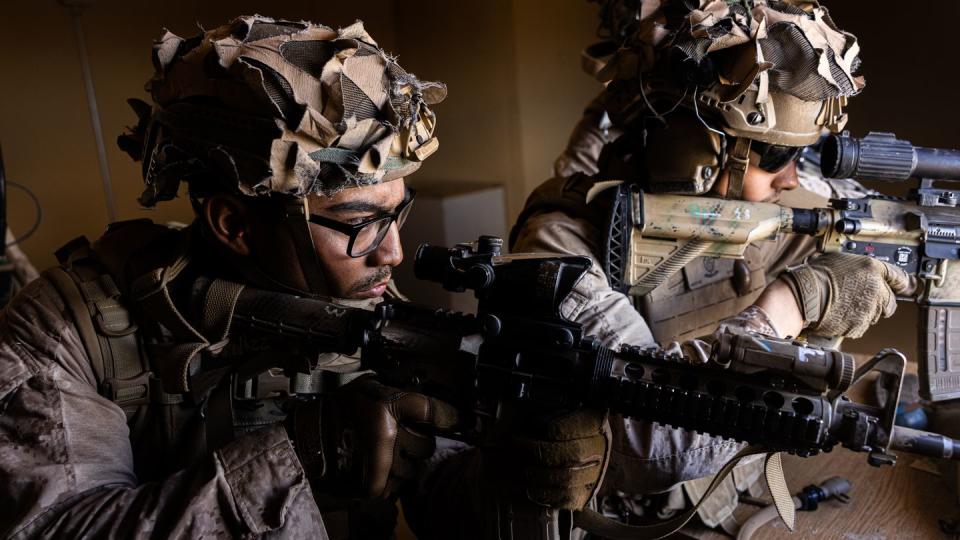
Recent changes
Leaders such as Heckl and others provided the first big-picture public view of the results of nearly two years of conceptual work and experimentation for phase I of the infantry battalion experiments in June.
Those experiments looked various configurations among three different battalions: 1st Battalion, 2nd Marine Regiment, at Camp Lejeune, North Carolina, with a 735-Marine battalion; 1st Battalion, 1st Marines, at Camp Pendleton, California, with an estimated 930 Marines and 1st Battalion, 3rd Marines, at Marine Corps Base Hawaii with a mixed version in the middle.
Before these experiments began, the infantry battalion manning stood at approximately 965 Marines, which emerged from an early 1980s study and reconfiguration that reduced the post-Vietnam War sized battalion of more than 1,000 Marines.
The new Marine manning now sits at 811 Marines and 69 Navy support personnel in the infantry battalion after phase one concluded.
Over that same period, during Berger’s tenure, the Corps has reduced its conventional artillery while increasing rocket-launched artillery such as the high mobility artillery rocket system, or HIMARS. The service removed tanks from its entire inventory and reduced the number of infantry battalions overall.
There are 21 active-duty infantry battalions and eight Marine Reserve battalions. The service cut three active-duty infantry battalions since 2020 as part of Force Design 2030.
This summer two battalions already had transitioned to 811 Marines, according to data provided by Manpower & Reserve Affairs.
The remaining battalions will transition on this schedule: two in fiscal year 2024; three each in fiscal years 2025 and 2026; four each in fiscal years 2027 and 2028 and the final three in fiscal year 2029.
As of June, the Marine Corps had 2,148 officers and 22,805 enlisted Marines with infantry as their primary job in the active duty ranks, according to manpower data. Another 353 officers and 4,721 enlisted Marines held infantry primary jobs in the Marine Reserve as of late May.
Phase I experimentation:
Removing snipers from the battalion and instead creating a “scout platoon” to conduct some of the past functions of snipers in the headquarters & service company.
Increased headquarters & service company capacity, such as added radio operators, a motor transport officer and chief, administrative clerks, warehouse clerks and food service specialists.
Reorganized rifle company elements into a weapons platoon manned with machine gunners, mortarmen and antitank missile gunners.
Added medical training and personnel for improved casualty care in austere locations where immediate medical evacuation may not be available.
Increased 81 mm mortar platoon with two additional, for a total of four fire direction centers and organic precision fire section personnel in each rifle company.
Added signals intelligence and electronic warfare capabilities at the company level.
Enhanced command and control, sensing, lethality and sustainment experimentation.
Experiments to reduce cognitive load on leaders at all levels, including a new course for company noncommissioned officers on running 21st-century combat operations.
Removal of the assistant squad leader and one rifleman from each squad. The squad now contains 13 Marines instead of the previously configured 15 Marines.
Source: Marine Corps
Each of the three rifle companies within the battalion contains individual operations, signal, logistics, electronic warfare and medical sections. Plans now involve having a corpsman available for every squad.
The headquarters & service company holds its standard “S” shops ― S-1, 2, 3, 4, 5, 6 ― battalion medical and a fires platoon with 81 mm mortar platoon and operations fires section. The scout platoon falls under S-2.
Combat Development and Integration released a 13-minue video online in mid-August outlining some of the phase I changes.
In the video, Experiment Division Director Col. Christopher Bronzi emphasized that the changes were driven by modern battlefield threats and the increased need for lower echelon precision strike, counter-drone and electronic warfare.
The new formation, he said, would provide enhanced sensing, command and control, lethality and sustainment for the battalion, an “increased capacity to sense, make sense and strike the enemy.”
The colonel noted “more maturity” at every echelon.
That means sergeants leading fire teams, staff sergeants leading squads, gunnery sergeants co-leading platoons with second lieutenants, master sergeants and captains running companies, sergeants major alongside lieutenant colonels at the battalion level and colonels at the regiment.
Except for the sergeants major, that is a rank up or more for every position within the formation.
Studies looking at staff sergeant squad leaders date back at least for the past five years. However, in high-demand rotations and depleted manpower, corporals and sometimes even lance corporals have served as squad leaders in combat over the recent war on terrorism.
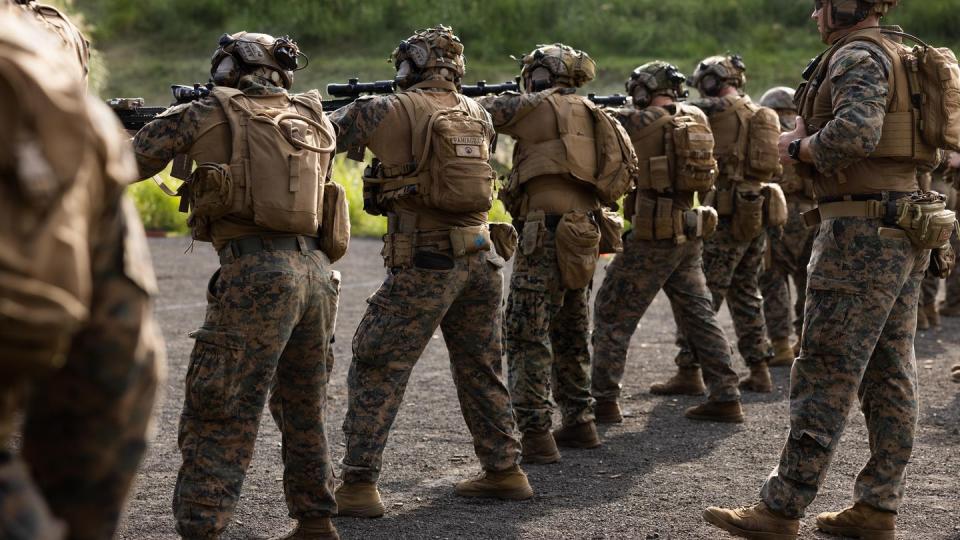
Sgt. Kristopher J. Hassemer, Marine Corps Warfighting Lab fellow in the experiment division said in the video that they’re focused on organic power generation at the battalion and company level and optimized power management at the platoon and squad level. Each part of the battalion will carry more electronic equipment than ever before.
The experiments have added water purification capabilities, increased tactical unmanned aerial and ground systems with a focus on tactical resupply unmanned aircraft systems.
In the video, Capt. Michael J. Hogan, assistant team leader on the infantry battalion experiment concept development team, noted increased drone capabilities and the incorporation of signals intelligence and electronic warfare teams. The scout platoons will “generate multidomain effects.”
Hogan answered a controversial decision to replace scout snipers with scouts by noting that “removing precision rifle employment” allows scouts to focus on recon, surveillance and target acquisition.
Maj. Daniel C. Phillips, team leader for the concept development team, said in the video that the “hallmark” of new command and control focus was to have a shared common operating picture from squad to battalion. That will include MESH network radios, which allow users to share voice, data and video through the best pathways across a communication network, network-on-the-move company vehicles and beyond-line-of-sight communication at the squad level.
The result, Phillips said, would be reducing deconfliction time and location reporting, rapid kill change closing and secure communications on the move to companies as well as giving users multiple waveforms to communicate in cluttered electronic environments.
First Lt. Michael Meier, a Marine Corps Warfighting Lab fellow working with the battalion experiment development team and former company executive officer for 3rd Battalion, 4th Marine Regiment, the on deck phase two experimentation unit, updated lethality changes.
In the video, Meier pointed to both Javelin and multipurpose anti-armor anti-personnel weapons systems in the company, precision rifles in the company arms room and integration of aerial loitering munitions.
This combination gives the company a 50 km reach for organic fires. Previously that range stood at 3.4 km with the 60 mm mortar. And the 60 mm mortars remain in the company, spokesman Maj. Eric Flanagan told Marine Corps Times.
Brig. Gen. Kyle B. Ellison, commanding general of Marine Corps Warfighting Lab and 30-year infantryman, summarized much of the explanation by highlighting the changes will increase lethality and maneuverability while enhancing combined arms across all domains and improving and increasing casualty care.
He took an extra beat to emphasize what the experiments are not doing, which is creating an infantry battalion unable to adapt to changing mission essential tasks, operate on the offense and defense.
“This is not about major course corrections…about one to two degree rudder steers,” Ellison said. “It’s about a journey, not a destination.”
The ‘threat of the ‘80s’
In the late 1970s, then-Marine Corps commandants Gen. Louis H. Wilson Jr. and his successor Gen. Robert H. Barrow, conducted outside studies and internal work on reducing and rearming the infantry battalion and preparing it for the “threat of the eighties.”
The Corps had left the Vietnam War only a few years before having seen its infantry conduct mostly dismounted patrols in jungle, hilly and sometimes urban terrain. But the likely foe on the horizon would be the Soviet Union, an armor and artillery-centric force.
While the Army’s mass centered in Europe to meet that threat, the Corps needed to find its way to fight on the edges or in key positions of any potential conflict. That was the vision of the service’s leaders, according to multiple accounts in historical documents Marine Corps Times reviewed recently at the service’s Quantico, Virginia, archives.
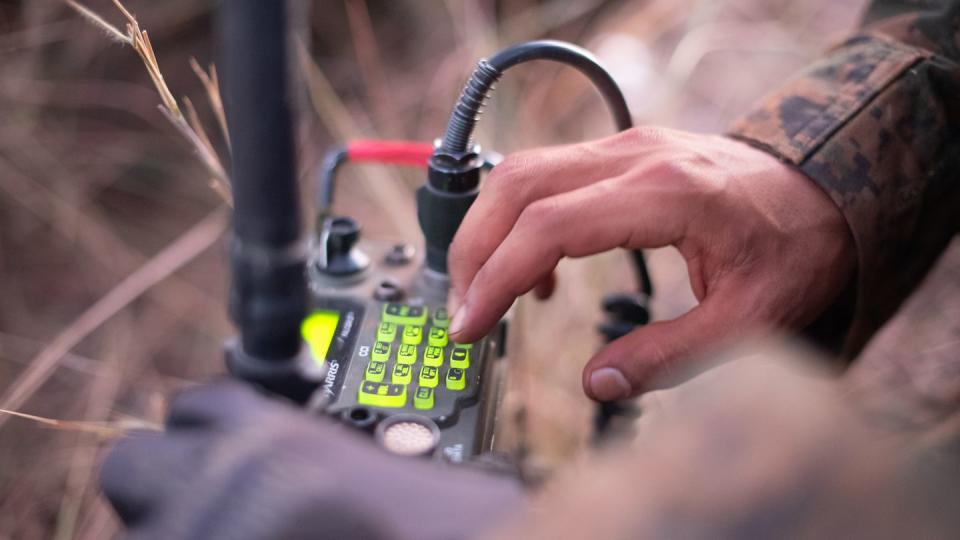
One study encapsulated the effort and would change the structure of the infantry battalion in some ways to present day ― the “Marine Infantry Battalion 1980–1990 Study.”
Initial work came out of an independent review of the battalion’s combat effectiveness and recoverability should it sustain casualties by Science Applications, Inc. completed in November 1979.
From the outset, the commandant and senior leaders looked to reduce the infantry battalion’s size to 900 Marines or fewer, down from more than 1,000 Marines in its previous war footing.
Retired Lt. Gen. Paul Van Riper, whose final posting was running Marine Corps Combat Development Command from 1995–1997, told Marine Corps Times that the initial focus first on manning then on capabilities in that study resulted in some positive and some “ludicrous” changes. But he maintains that the initial push to focus first on manning due to lower Corps end strength was “flawed from the start.”
“The Marine Corps didn’t arrive at a 1,000 Marine battalion with heavy weapons and a weapons company without a hell of a lot of combat experience,” Van Riper said.
The retired three-star first enlisted in 1956 and retired in 1997. At the time of the 1980 study and its later implementation Van Riper was a lieutenant colonel commanding 2nd Battalion, 7th Marine Regiment. He and a group of other retired senior Marine officers have been openly vocal critics of major changes that have happened in recent years under the previous Commandant Gen. David Berger.
The 1980 battalion study resulted introduced the M198 155 mm howitzer, increased other conventional artillery, added a 24 BGM-71 TOW anti-tank, guided missile launchers, the Mk-19 automatic grenade launcher, M2 .50 caliber machine gun, the Mk-153 shoulder-launched multipurpose assault weapon and the squad automatic weapon, a 5.56 mm light machine gun. The changes also increased the number of M47 Dragon anti-tank missile launchers from 24 to 32.
While the firepower was a welcome addition, both Van Riper and Schmitt, who served first as a rifle platoon commander then as the anti-armor platoon commander in 3rd Battalion, 6th Marine Regiment, an experimental unit in the 1980s battalion study, had to make major adjustments on the ground.
Van Riper recalls a practice by which two Marines were expected to run a vehicle with both a Mk-19 and a .50 caliber machine gun. One Marine driving, the other firing, and only one weapon could be mounted at a time. That move proved not only cumbersome and demanding, but risky at best.
He noted that should one of those two Marine be wounded, that would essentially take two guns out of the fight. At the time the M60 machine gun, a 7.62 mm gun used routinely required a three-Marine contingent to operate, he said.
Schmitt recalls commanders repurposing some of the machine and grenade-launcher mounted vehicles, Jeeps at the time, to conduct nuclear and radiological reconnaissance because the battalion had no such capabilities but still faced that threat.
As the anti-armor platoon commander, Schmitt received his fill.
“The relevant thing is that it went from a (table of organization) of 56 (Marines) to a TO of 96 in response to the threat posed by Soviet armor,” he said.
But overriding any equipment employment questions and the blessings of more firepower, the biggest change that thwarted effective efforts was the introduction of the 11-Marine squad. Down from the decades-long, combat-proven 13-Marine squad.
The Corps has used a 13-Marine squad formation, the building block of its platoons, companies and battalions, since at least the 1950s. The squad centered around a single squad leader coordinating three, four-Marine fire teams.
Marines were being tasked with more weapons, more mobility and more communications, but losing two Marines in each squad.
And that figure flowed across the formation, Van Riper noted.
“Here’s the usual argument on manning ― ‘technology makes the individual Marine, fire team or squad more effective, therefore we cut,’” he said.
But by cutting the rifle squad from 13 to 11, he said. With 13-Marine squads, the organization remained three-quarters effective when it took a casualty. But with 11 Marines it’s now only two-thirds effective.
When leaders at the time cut for the sake of meeting manning numbers and adding tasks and tech, they were simply thinking about bringing fire upon the enemy but not about the resiliency of a squad, he said.
By 1984, 60% of the Corps’ battalions had shifted to the new formation. But the Corps had already switched back to a 13-Marine squad after reports from the field.
Recent squad changes
In 2016, 3rd Battalion, 5th Marine Regiment, conducted a series of experiments over a six-month period looking at how the Corps could increase the situational awareness and firepower of the squad and what the composition of the unit could be. The experiments looked at various manning structures.
While wrapping a tour with FAST Company, then-Capt. Joe Patterson got a call from the infantry career monitor who asked if he wanted to return to his old unit, 3rd Battalion, 5th Marines, in Camp Pendleton, California, and lead a company. The only other thing he remembered was the monitor asked how he felt about experimentation.
“I said, ‘Great, let’s go,’ I just wanted to go back to 3/5,″ Patterson said.
He thought the experiments might mean adding female infantry Marines to the unit, which had only begun a short time before.
Patterson served as Kilo Company commander during the Marine Air-Ground Task Force Integrated Experiment, which lasted until 2017.
Kilo Company and its two fellow companies each used various options at the platoon level but once the initial part of the test concluded, his company went with the 15-Marine model.
He reported to his unit on a Friday and found his executive officer filling rosters, pulling in Marines from across the Corps. Every billet was filled with a senior rank for that spot. Experienced sergeants were leading squads, all his fire team leaders were corporals, both a rarity in a stretched-thin, constant deploying Corps over the previous decade.
And it wasn’t only riflemen. He was getting engineers, mechanics, more communications Marines, generators, water purifiers, drones and radio equipment that few at his level normally had in their gear locker.
He went from 160 Marines in the company to 350 in about a week, he said.
The next four months whipped by at breakneck speed. Individual training on the new gear lasted one to two weeks, nearly every Marine learned how to purify water, talk on and troubleshoot radios then work as fire teams, squads, platoons then as a company in a couple of months.
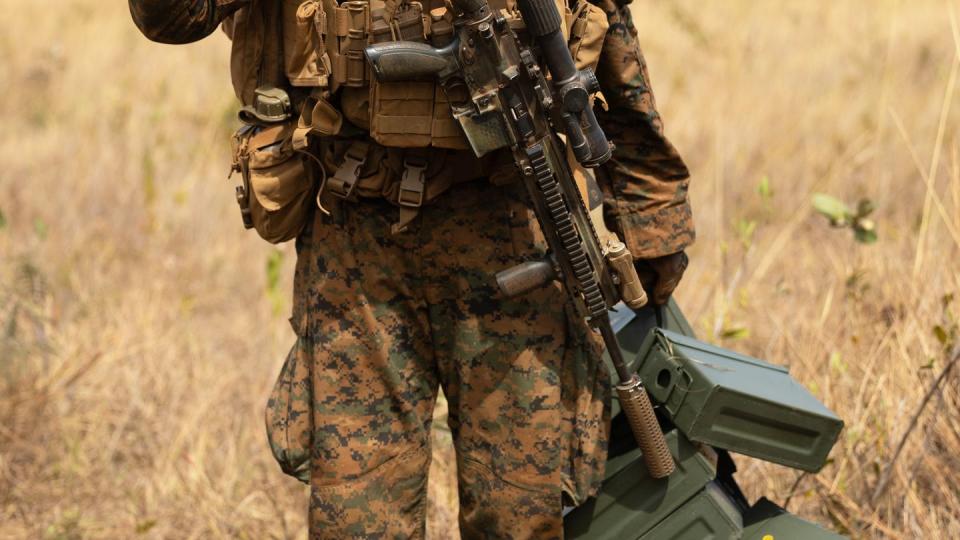
“The idea was that we could all hop into an aircraft run an over-the-horizon mission, conduct long range operations and be completely self-sustained and live off the land without long logistics chain back to the (Marine Expeditionary Unit Amphibious Readiness Group),” he said.
Patterson described it as “old-school Vietnam” type of fighting with modern technology.
“By the end of the company phase of this, man I tell you I wouldn’t have wanted to be the bad guys on the other end of what we were delivering,” Patterson said.
Along the way, he said, they were told repeatedly that they were the tip of the Marine Corps spear and treated as such. That meant countless visits from distinguished guests, endless questions and feedback from experts and never-ending after action reviews for the Marine Corps Warfighting Lab.
“This was not the traditional company command experience,” he said. “I was under the microscope. Everything we did was evaluated and graded; we were tested constantly.”
What that led to for this captain was something now commonly called “task saturation.”
The bombardment of more information than perhaps any Marine company commander had ever seen sometimes stalled decision-making. And he worried it would do the same for a squad alone in a combat zone. The formation needed extra bodies simply to provide security while leaders looked at screens, ran comms or did the myriad of more complex tasks being asked of them.
Even he was overwhelmed. At one point stuck trying to figure out how to employ a machine-gun equipped robot in the firing and maneuvering. There were no manuals for this.
But a friend broke him out of his own fog.
“Hey dude, you know what it still is?” a friend asked. “A machine gun. Employ it like you would a machine gun.”
The companies in the experiment also got a batch of the then-new MRZR, the four-person off road vehicle that would later be fielded as the ultra-light tactical vehicle now providing most of the tactical wheeled mobility for the company. That one change helped his Marines zip around corners of the battlespace in ways they’d never had.
Looking back, Patterson sees how some automation could reduce the workload on his Marines in some ways but increase it in others. He’s happy the Corps went with the 15-Marine squad for exactly that reason. Though it has since reverted to the 13-Marine squad.
Patterson led a platoon on a combat tour in Sangin Valley, Afghanistan, in 2010, during some of the most intense fighting there during that phase of the war.
At one point the unit took three casualties at the same time. All research and reports indicate that any near peer conflict would see casualties that dwarf anything experienced during the war on terrorism, rivaling perhaps the figures seen during World War II.
Those three casualties took two squads to evacuate. One to carry them off the battlefield and the other to provide security while they did. A smaller squad would have been crippled by that incident.
Patterson recalls the final phase of the experimentation, a two-week, self-sustained field exercise culminating in a massive live fire event that featured robot battle buddies, scavenged power sources and a variety of new drone, communications and fires options, as one of the most rewarding of his more than two-decade career.
“I didn’t have anything to do as I’m leading this attack. I just ran behind my guys, shouted nice things at them and watched the beautiful destruction occur,” Patterson said.
About a year later, in May 2018, then-Commandant Gen. Robert B. Neller announced that the Corps would move to 12-Marine rifle squad.
The new squad lost a Marine but gained the following: the M27 infantry automatic rifle which replaced the M4, a common handheld tablet, multi-channel radios and a better grenade launcher, the M320 replacing the rifle mounted M203.
But by the end of the year, Neller had pivoted and wanted to see how a 15-Marine rifle squad would perform.
In 2019, 2nd Battalion, 8th Marine Regiment, deployed with the 26th Marine Expeditionary Unit out of Camp Lejeune, North Carolina, with a complete 15-Marine rifle squad structure. The formation had kept the 13-Marine base and added an assistant squad leader and squad systems operator.
And, until mid-August, that was the publicly announced squad configuration. But in a mid-August online video explainer rollout of the new infantry battalion, the squad has now reverted to the 13-Marine structure, keeping the squad systems operator and cutting the assistant squad leader and one rifleman from the ranks.
Heading into phase two, the Corps has decided to use the 13-Marine rifle squad structure due in part to manning considerations, Flanagan said. As experimentation continues, planners will continue to evaluate the squad.
Both 3rd Battalion, 4th Marines, battalion commander Lt. Col. Bryceson Tenold and battalion Sgt. Maj. Trevor L. Goff are set to lead the battalion through the next two years of experimentation. The pair are already receiving Marines, some of which were in units involved with phase one experiments.
Tenold and Goff told Marine Corps Times in a mid-August phone interview that they plan to set the tone for the right kind of culture in the battalion that aims to rapidly build up skill sets and teams through openness and sharing of lessons learned.
Between now and the end of the year many Marines in the unit or headed to it will attend a variety of training schools and continue that training on new equipment and methods of employment in the coming months.
An estimated 500 Marines of the 811-Marine battalion are already on station, Goff said. The remainder should arrive by November. Some internal shifting will occur as promotion boards for various ranks across the Corps release promotion data in the coming months.
That’s important because the aim is to have sergeants as fire team leaders, staff sergeants as squad leaders, gunnery sergeants as platoon sergeants, master sergeants as company sergeants and sergeants major as both battalion and regimental sergeants major. All of those with the last two exceptions were previously filled by ranks at least one, sometimes two ranks below.
The “Thundering Third” won’t get to operate in a vacuum, Goff emphasized they’ll be simultaneously experimenting with the new battalion structure while also readying for any crisis response, contingency or larger scale exercises and operations the division or Marine expeditionary force tasks them.
When the pair learned they’d be leading this battalion at the edge of new experimentation, each had their own reactions.
After a nearly three-decade career, Goff said he and his Marines have a lot of excitement about being part of this historic effort and that its shows the Corps is “willing to redefine and refine the infantry battalion and continue to refine it along the way.”
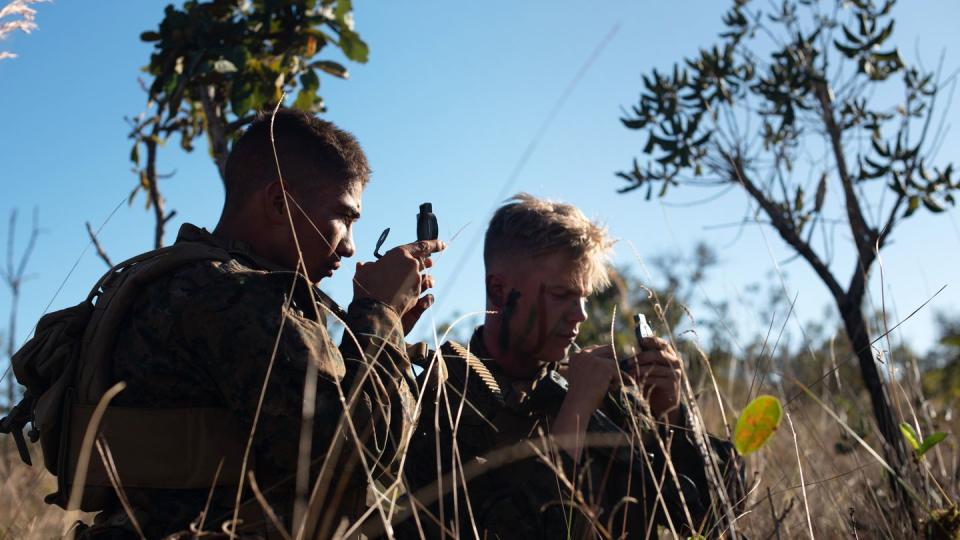
He’s already stressing to his junior Marines that the input they’re able to give the institution will inform how the future battalion is designed and deployed.
Tenold sees this as a great opportunity, both to command an infantry battalion and to set in motion options for senior leaders to evaluate as they develop the way ahead for Marine Corps infantry.
Patterson retired as a major in 2022. And while he doesn’t closely follow every detail of Marine infantry any longer, his heart remains close to those ground-pounders with whom he served.
His has simple advice for the captains leading companies at 3rd Battalion, 4th Marines.
To re-read MDCP-1 “Warfighting” and apply its principles. And no matter what “Gucci gear” they get and to stick with infantry 101.
“Don’t get lost in the sexiness,” Patterson said.
“A Marine is still a Marine and nothing is more dangerous and lethal than a Marine with his rifle and all of this stuff you are going to experiment with is going to enhance that Marine and not replace. So don’t overthink it.”
The story before the story
Marine Corps Warfighting Lab commander Ellison specifically noted in the video explainer that the battalion will remain ready to accomplish its historic tasks along with its new missions.
But not everyone is yet convinced, Schmitt among them.
Schmitt, who wrote “Warfighting” under the supervision and inspiration of a maneuver warfare shift within the Corps driven largely by the much lauded 29th Commandant Gen. Al Gray, has concerns that Force Design 2030 and its focus on sea control and denial may be the war that the Corps wants to fight, rather than the one it will be forced to fight ― one that includes close combat.
“I think the thing that has generated a lot of the resistance is not just the dramatic change in infantry numbers, because the Marine Corps is always tweaking numbers, but it’s the fact that that change is taking place within the framework of a new concept for warfare that not everybody’s bought into.”
The combined arms, maneuver-inspired approach of even the smallest of Marine units set it apart from the hulking formations of the U.S. Army. That carved a unique niche that saw Marines employed and deployed for everything from embassy evacuations and battalion landing teams to fire missions and humanitarian aid over the past 40 or more years.
“We were that way precisely because we knew we couldn’t predict what was going to be needed. And that seems to be another thing that’s different today. There seems to be a belief that we know what we’re going to need, and we can start to tailor ourselves to this need.”
Should the Corps lose that flexibility, Schmitt said the move could change how others view the Corps’ purpose, which may sideline the Marines in the next fight.
But Schmitt admitted he doesn’t know all the details and could be wrong.
“Maybe the next fight is going to be a big fight in the South China Sea and Marines are going to distinguish themselves and everybody’s going to say, ‘Thank God for this new Marine Corps,’” Schmitt said. “I don’t know.”
Van Riper, a lifelong student and teacher of history, worries that current leadership has only looked at its most recent shadow as it prepares for the coming decades and not the long line of combat history that led to where the Corps’ formations have their origin.
Marine Corps Times requested documents, literature review or explanation and analysis of historical aspects as they relate to the infantry battalion. Those were not immediately available prior to publication of this article.
One day, back in the mid-1990s, while Van Riper headed Marine Corps Combat Development Command, he saw two majors with an appointment on his schedule.
They wanted to talk about the need to reorganize the Marine infantry Battalion.
“I said, gentlemen, let me tell you a story, when I came in the Marine Corps, we had a weapons company that went away. Now it’s back. When I came in, we had 60 mm mortars, they went away before Vietnam and then came back and then went away again. And I’ve seen this thing played over and over and over. We keep reinventing the wheel.”
Then he had a task for the two ambitious majors.
“I want you to tell me the history of the Marine Corps infantry battalion, so we don’t end up repeating things that are erroneous,” Van Riper said.
“They went away, and I never heard from them again.”

